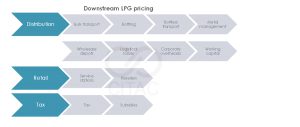Understanding LPG pricing along the value chain in Africa
LPG is the fastest-growing oil product in Africa and in CITAC’s view its future growth path is relatively clear of downside risks. In Sub-Saharan Africa, where biomass dominates the energy mix, CITAC expects LPG demand to triple from current levels to 12mn mt in 2035.
LPG’s robust fundamentals have spurred growing interest in how LPG is priced along the value chain—from FOB supply zone to end-consumer. Using examples from Morocco, Senegal, Côte d’Ivoire, Burkina Faso, Mali, Niger, Cameroon, Congo-Brazzaville, South Africa and Zambia, this Industry Insight seeks to identify the key principles that underpin LPG price regulation in Africa, highlighting common ground but also some of the differences in approach that invariably result from country-specific supply chains and regulatory frameworks.
The guiding principle behind official LPG price structures is that regulator-determined allowances for the various activities in the value chain should:
- Reflect the actual costs, including cost of capital, incurred by an efficient market player operating in a safe, compliant manner.
- Attract ongoing investment to the sector (if such investment is deemed necessary based on existing capacity relative to demand).
In countries where LPG pricing is controlled, regulators use this ‘(Efficient) Cost-Plus’ approach to pricing. In general, official price structures are clearly divided into ‘Import Parity’ and ‘Downstream’ portions.

Given that price structure allowances are always expressed on a unit basis, the regulator has the challenging task of defining typical, or ‘benchmark’, costs for each activity in the value chain. This is just one of the many considerations facing regulators as they seek to quantify acceptable cost and margin allowances in the LPG value chain.
In the medium- to long-term, LPG pricing in Africa is likely to remain subject to heavy regulator involvement, particularly in the residential sector, as governments seek to navigate the twin challenges of mass deforestation and huge population growth. In subsidised markets, benchmark price structures will continue to be necessary as a means of calculating the magnitude of any under- or over-recoveries owing to or from commercial players.
CITAC regularly carries out consultancy work in the LPG space. For more information, please contact info@citac.com.
This is an extract of the Insight Paper published in CITAC’s Sub-Saharan Africa Oil Market Report (Octobe 2020)
